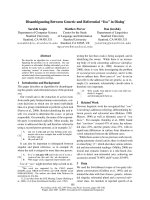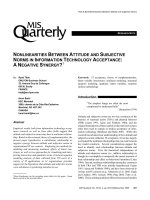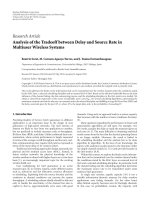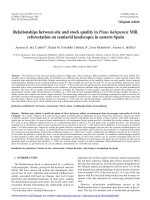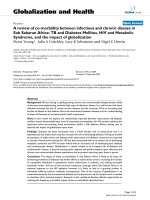Association between personality and neurocognitive dysfunctions in schizotypy clusters
Bạn đang xem bản rút gọn của tài liệu. Xem và tải ngay bản đầy đủ của tài liệu tại đây (871.57 KB, 108 trang )
ASSOCIATION BETWEEN PERSONALITY AND
NEUROCOGNITIVE DYSFUNCTIONS IN
SCHIZOTYPY CLUSTERS
ONG MIN YEE
B. Soc. Sci. (Hons.), NUS
A THESIS SUBMITTED
FOR THE DEGREE OF MASTER OF SOCIAL SCIENCES
DEPARTMENT OF PSYCHOLOGY
NATIONAL UNIVERSITY OF SINGAPORE
2011
i
Acknowledgement
I would like to express my great appreciation to my supervisor, Dr. Simon L.
Collinson for his continuous guidance, dedication and expertise in the field, and
his confidence in me. I would like to thank him for showing support for my work
and his contribution to my growth as a psychologist. I would also like to thank
him for the advices that he has given me throughout my Masters program and the
opportunity that he has provided me with an attachment at the Research
Department in the Institute of Mental Health (IMH).
I am also deeply grateful to Prof. Chong Siow Ann and Dr. Mythily Subramaniam
for the opportunity that they have provided me with. I would also like to thank the
team members of Translational Clinical Research (TCR) Project 1B for assisting
me with data collection, and Mr. Max Lam for his help on SPSS and data analysis.
I would also like to thank Ms. Loh Poh Yee for her help on admin matters.
To Melvin, I thank him for expressing his confidence in my ability and always
being there for me cheering me on. His support helps me to persevere on and do
better.
Finally, heartfelt thanks to my family for their continuous support,
encouragements, and always expressing their confidence in my ability. I thank
them for their love and always providing a listening ear and going through the
tough times with me. I would also like to thank my friends for their concerns and
ii
support. Their company and encouragements made this journey easier. Thanks
everyone!
iii
Table of Contents
Page
Acknowledgements
i
Table of contents
iii
Thesis summary
vi
List of Tables
viii
List of Figures
ix
Chapters
1.
2.
What is Schizotypy?
1
1.1.
Evidence of a Continuum model
3
1.2.
Schizotypy in the general population
6
1.3.
Measurement of Schizotypy
8
1.4.
Factor structure of Schizotypy
11
1.5.
Asian studies on Schizotypy
14
Schizotypy, Neurocognition and Personality traits
16
2.1.
Neurocognition
16
2.2.
Non-schizotypal personality traits
20
3.
Aims of Present study
23
4.
Method
25
4.1.
Participants
25
4.2.
Clinical scales and Personality questionnaires
26
4.2.1. Structured Clinical Interview for DSM-IV Axis I
26
Disorders, Non-Patient Edition (SCID-NP)
iv
Page
4.3.
4.2.2. Schizotypal Personality Questionnaire (SPQ)
27
4.2.3. State-Trait Personality Inventory (SPTI)
27
Neurocognitive assessment
28
4.3.1. Brief Assessment of Cognition in Schizophrenia
29
(BACS)
4.3.2. Benton Judgment of Line Orientation Test
32
(BJLOT)
4.3.3. WAIS-III Matrix Reasoning Task
32
4.3.4. Continuous Performance Test-Identical Pair
32
(CPT-IP)
5.
4.3.5. Wisconsin Card Sorting Test-64 (WCST-64)
33
4.4.
Procedure
36
4.5.
Statistical Analyses
37
Results
38
5.1.
Descriptive statistics
38
5.2.
Cluster Analysis
38
5.2.1. Clusters for Participants
39
5.2.2. SPQ Factors
39
Associations of Clusters and SPQ Factors with
41
5.3.
Neurocognition and STPI
5.3.1. Schizotypal Clusters
5.3.1.1.
Neurocognition
41
42
v
Page
5.3.1.2.
STPI
5.3.2. New SPQ Factors
6.
43
46
5.3.2.1.
Neurocognition
46
5.3.2.2.
STPI
50
Discussion
54
6.1.
Schizotypal clusters and SPQ factors
55
6.2.
Associations of schizotypal clusters with
57
Neurocognition and STPI
6.3.
6.2.1. Neurocognition
57
6.2.2. STPI
58
Associations of SPQ features with Neurocognition
60
and STPI
6.3.1. Neurocognition
60
6.3.2. STPI
66
6.4.
Implications of present study
69
6.5.
Study limitations and future directions
71
6.6.
Conclusions
73
7.
References
74
8.
Appendices
94
8.1.
Appendix A
94
8.2.
Appendix B
95
vi
Thesis summary
Studies have shown that individuals with schizotypy share similar
neurocognitive impairments and certain personality traits as those found in
clinically diagnosed schizophrenia patient. As a multidimensional construct,
schizotypy consists of multiple personality features including cognitions, beliefs
and behaviors. Similar or co-occurring features are grouped together forming a
schizotypal cluster. To date, only a few studies have focused on associations
within individual schizotypal clusters. The aim of this thesis is to understand the
complex relations within and between individual schizotypal clusters and identify
potential neurocognitive endophenotypes and non-schizotypal personality traits
that may indicate enhanced risk for schizophrenia.
English speaking Singaporean Chinese (N = 198) were assessed by the
Schizotypal Personality Questionnaire (SPQ), cognitive functions through the
Brief Assessment of Cognition in Schizophrenia (BACS), and non-schizotypal
personality traits by the State-Trait Personality Inventory (STPI). A two-way
clustering analysis was performed for generating schizotypy clusters and SPQ
factors. Three schizotypy clusters (Low, High Positive, and High
Positive/Negative) and three new SPQ factors (Referential Thinking, Anxiety, and
Social Interaction Deficit) were found. In relations to positive schizotypal features,
individuals scoring high on SPQ performed poorer on almost all neurocognitive
measures especially on working memory, attention, non-verbal abstract problem
solving and executive functioning. No correlation was found with negative
schizotypy. In addition, individuals with high schizotypal traits were found to
vii
report higher levels of negative emotions such as anger, anxiety and depression.
State anxiety best predicted high schizotypal individuals under the Referential
Thinking factor, trait curiosity was found to negatively predict high schizotypal
individuals under the Anxiety factor, and trait anger predicted high schizotypal
individuals under the Social Interaction Deficit factor.
These results showed that different profiles of schizotypal features
contribute to the heterogeneity of neurocognitive functioning, emotional states
and personality traits. Along with present findings and future genetic research and
more formalized measures, future studies may possibly create a form of
classification system useful in simplifying the complex nature of schizotypy.
viii
List of Tables
Page
1.
Self-report scales for measuring schizotypy
10
2.
BACS tests in the MATRICS neurocognitive domains
31
3.
Measures used in present study
35
4.
Demographic data based on schizotypy clusters: mean (SD)
41
5.
Kruskal-Wallis tests showing differences between clusters
on STPI subscale
44
6.
Logistic regression analysis of high positive/negative
schizotypy cluster with STPI
45
7.
Pearson‟s correlations between new SPQ factors and
neurocognitive tests
47
8.
Pearson‟s correlations between new SPQ factors and
neurocognitive tests within individual schizotypal cluster
49
9.
Regression coefficients between STPI and new SPQ factors
51
10.
Regression coefficients between STPI and new SPQ factors
within individual schizotypal cluster
52
ix
List of Figures
Page
1.
Figure showing a Continuum model
3
2.
Mean values of each STPI subscales for the schizotypy clusters
45
3.
Mean values of each STPI subscales for low and collapsed high
schizotypy clusters
46
1
1. What is Schizotypy?
Schizotypal personality, often referred to as schizotypy, is a
multidimensional construct which refers to a collection of biologically determined
personality factors that are reflected in cognitive style and perceptual experiences
and manifest as sub-clinical levels of psychotic-like behaviors in psychologically
healthy individuals (Claridge, 1985). Within the general population, the incidence
of positive psychotic experiences such as thought interference, persecution and
auditory hallucination has been found to be 100 times greater than the incidence
of psychotic disorders such as schizophrenia (Hanssen, Bak, Bijl, Vollebergh, &
van Os, 2005). Consistent findings indicate that a substantial proportion of
individuals experience hallucinations or delusional phenomena of some kind at
some point of their lives (Barrett & Etheridge, 1992; Eaton, Romanoski, Anthony,
& Nestadt, 1991; Posey & Losch, 1983; cited in van Os, 2003). Approximately 28%
of individuals in the general population endorsed psychosis-screening questions
as measured by the US National Comorbidity Survey (Johns & van Os, 2001).
However of the 28%, only 0.7% falls into the broadly defined psychosis upon
clinical diagnosis (Kendler, Gallagher, Abelson, & Kessler, 1996; cited in Johns
& van Os, 2001). Whilst overt experiences may not persist and continue to
manifest sub-clinically, in some cases schizotypy may be a precursor to the
development of a clinical syndrome.
Schizotypy may also be viewed as the premorbid stage of clinical
disorders such as schizophrenia and other schizophrenia spectrum disorders
including schizotypal personality disorder (SPD), schizoid personality disorder,
2
and schizoaffective disorder. Schizophrenia is a mental disorder characterized by
disturbances in thought, emotion, and behaviors which affect one‟s social,
cognitive and emotional functioning (Kring, Davison, Neale, & Johnson, 2007). It
is estimated to affect 1% of the population (Johns & van Os, 2001). In contrast,
SPD is a disorder viewed as the attenuated form, or prodromal stage of
schizophrenia (Raine, 2006). The criteria for SPD were first derived from an
examination of clinical features that characterized borderline schizophrenia
patients who were mainly the first- and second-degree relatives of schizophrenia
adoptees in the Danish Adoptee Study (Kety, Rosenthal, Wender, & Schulsinger,
1968; cited in Squires-Wheeler, Skodol, Friedman, & Erlenmeyer-Kimling, 1988).
These criteria were put forth in the Diagnostic and Statistical Manual of Mental
Disorders, Third Edition (DSM-III; American Psychiatric Association, 1980),
which focused on SPD rather than schizotypal personality per se. Prevalence rate
of SPD has been estimated at around 2% to 3%, and it has been found to have
similar cognitive and neurobiological deficits as that of individuals with
schizophrenia (Sperry, 2003).
3
Figure 1. Figure showing a Continuum model. A continuous relationship between level of
psychotic symptoms and need for care. Point A represents schizotypy in the general
population, point B represents schizophrenia spectrum disorders such as SPD, and point
C represents schizophrenia.
1. Johns & van Os, 2001.
Taken together, a continuum is formed (shown in figure 1) ranging from
relative psychological health to various degrees of subclinical deviance to
schizophrenia spectrum personality disorders and to full-blown schizophrenia
(Raballo & Parnas, 2010). Schizotypy at best may be viewed as a cluster of
personality traits that are found to be varied among healthy individuals in the nonclinical general population.
1.1. Evidence of a Continuum model
Theoretical models have been developed over the years to understand the
continuity from sub-clinical behaviors as found in schizotypy to clinically
diagnosable psychopathology within schizophrenia spectrum disorders. Three
theoretical models of schizotypal personality have been developed: the quasi-
4
dimensional model (Meehl, 1962), the totally dimensional model (Eysenck, 1947),
and the fully dimensional model (Claridge, 1997).
Meehl‟s (1962) quasi-dimensional model represents a categorical
approach to schizophrenic etiology by delineating a clear distinction between
signs of health and those of disorder. According to this model, schizotypal
personality traits are likely to have biological origins, such as developmental
neural defects that may predispose to schizophrenia. This concept is known as
schizotaxia (Meehl, 1990). The quasi-dimensional model views schizotypy as a
personality organization resulting from the interaction of an inherited schizotaxia
brain that combined with environmental factors ultimately lead to the outward
expression of vulnerability similar to, but less of schizophrenia (Green, Boyle, &
Raine, 2008). This model focuses on abnormal brain states and schizophrenia-like
behaviors; thus continuity of functions is placed in the abnormal sphere rather
than a continuation from normal to abnormal. Hence the quasi-dimensional model
does not illustrate continuity of psychotic experiences from the general population
to clinically diagnosed illness.
On the other hand, the totally and fully dimensional models propose
continuity of schizotypal personality traits from the general population to clinical
disorders. Eysenck‟s (1947) totally dimensional model does not make any
distinction between enduring psychotic experiences and signs of abnormality.
While the fully dimensional model by Claridge (1997) proposes a distinct
boundary along the schizotypal-schizophrenia continuum, where discontinuity of
functions denotes the disorder (Green et al., 2008) and variations in perceptual
5
experiences in the general population are deemed as normal (Claridge & Beech,
1995; cited in Green et al., 2008). This model thus proposes a continuum of
personality traits and dispositions that range from healthy functioning to florid
psychosis as found in schizophrenia and SPD. According to the fully dimensional
model, symptoms and dysfunctions observed in schizophrenia may be regarded as
exaggerated manifestations of traits that can be found in healthy individuals
(Avons, Nunn, Chan, & Armstrong, 2003). Schizotypal traits may represent both
adaptive variations in personality and maladaptive psychological functioning.
In agreement with the fully dimensional model, Rose and Barker (1978;
cited in van Os, 2003) proposed that disease at the level of the general population
normally exists as a continuum of severity rather than as an all-or-none
phenomenon. Diathesis-stress models support this view. Diathesis, or
vulnerability, is the notion of predisposition that confers greater than average
liability to develop an illness, in this case schizophrenia (Parnas, 1999). Such
liability is assumed to be genetic or biological dysfunction. Besides genetic
vulnerability, the presence of other personality traits, absence or presence of
protective factors, psychosocial factors and external factors such as adverse life
experiences may also play a part in the transformation (Green et al., 2008).
Diathesis-stress models thus claim that only a certain fraction of vulnerable
individuals, when additionally exposed to environmental stress factors, develop
overt schizophrenia psychosis, while the remaining either exhibit subclinical
manifestations or asymptomatic (Parnas, 1999).
6
Evidence for a continuum of severity in schizophrenia spectrum disorders
is supported by reported differences in cognition, behavior and the likelihood
conversion to schizophrenia. For instance, studies of cognitive dysfunction in
schizophrenia-spectrum participants have shown that people with SPD performed
intermediate to healthy controls and schizophrenia patients on measures of
attention, abstract reasoning, cognitive inhibition, memory and general
intellectual functioning (Cadenhead, Perry, Shafer, & Braff, 1999). Several
authors have also reported that anxiety and depression were strongly associated
with the positive factor of schizotypy, similar to that of schizophrenia studies‟
findings (Emsley, Oosthuizen, Joubert, Roberts, & Stein, 1999; Lewanowski et al.,
2006). In another study, 7.6% of children at age 10 with schizotypal-like
diagnosis were diagnosed with schizophrenia by age 27 (Wolff, Townshend,
McGuire, & Weeks, 1991).
Based on these findings, a continuum of severity can be found ranging
from schizotypy in the general population to schizophrenia spectrum disorders,
which lends support to Claridge‟s fully dimensional model. Hence, schizotypy
and SPD can be viewed as qualitatively similar to, but quantitatively less severe
than schizophrenia (Linney et al., 2003).
1.2. Schizotypy in the general population
The continuum model, as reviewed, justifies the use of psychometrically
defined schizotypal individuals from the general population that may provide
potential insights into schizophrenia and other schizophrenia spectrum disorders.
7
Psychometrically defined schizotypal individuals are healthy individuals from the
general population who score high on measures of schizotypal personality. This
approach has advantages over the investigation of schizophrenia patients as
clinical studies are often confounded by factors such as long-term hospitalization,
effects caused by psychotropic medication and general intellectual impairments
(Avons et al., 2003; Cadenhead et al., 1999). Studies of schizotypy avoid these
problems that are inherent in studies involving schizophrenia patients. Thus,
schizotypy studies provide the opportunity to investigate biological and cognitive
markers of vulnerability for schizophrenia.
In addition, the nature of different populations from which schizotypal
subjects are derived may also significantly impact the findings. For instance, most
of the current literature involved student population due to ease of recruitment.
However student population may prevent generalizability of findings, as they tend
to be high functioning and more cognitively advantaged than the normal
population (Gooding, Matts, & Rollman, 2006; Kendler et al., 1991). Furthermore,
student participants are similar in characteristics, stage of life and stress, and
therefore lack diversity. Conversely, variations can be observed in the general
population and findings are more generalizable as compared to findings from
student samples. Hence research samples taken from the non-clinical general
population are much superior to student samples.
A final advantage of using psychometrically defined schizotypes is the
ability to obtain information that are useful for early detection of „high-risk‟
individuals developing psychosis and therefore allowing preventive measures to
8
be taken (Green et al., 2008). Schizotypy thus serves as a basis for investigating
predispositions to schizophrenia and schizophrenia spectrum disorders (Avons et
al., 2003).
1.3. Measurement of Schizotypy
There are two ways of assessing schizotypy in the general population: 1)
the familial approach, which involves the study of aberrant but non-psychotic
biological relatives of schizophrenia patients (Claridge, 1985; Kendler, 1985), and
2) the clinical approach, which involves psychometrically defined individuals
high on schizotypal traits regardless of family history of illness (Kendler, 1985).
The familial approach observes possible schizotypal characteristics found in
relatives of patients due to potential existing heritability and relatives of these
patients may display attenuated forms of symptoms. On the other hand, the
clinical approach targets individuals who score high on self-report scales that
measure schizotypal personality traits regardless of whether they have an existing
heritability or not. These two perspectives provide different ways to investigate
the complexity of symptoms in schizotypal personality.
Schizotypal personality traits are usually measured through self-report
scales where participants were asked to answer a series of questions pertaining to
previous psychotic and psychosis like experiences. The content and style of
psychometric measures of schizotypal personality traits vary according to
investigators‟ aims and theoretical standing (Green et al., 2008). Presently,
several different scales are used widely; some focus on measuring attenuated
9
forms of specific schizophrenia symptoms, such as perceptual aberration
(Chapman, Chapman, & Raulin, 1978), magical ideation (Eckblad & Chapman,
1983) and the like. While other psychometric scales, such as the Schizotypal
Personality Questionnaire (SPQ; Raine, 1991) and the Oxford-Liverpool
Inventory of Feelings and Experiences (O-LIFE; Mason, Claridge, & Jackson,
1995), focus on tapping the general schizotypy construct based upon empirically
observed factor structure of schizotypy. A list of self-report scales for measuring
schizotypal personality traits may be found in Table 1.
Although self-report scales are widely used, they are not the best form of
measurement. For instance, participants are asked to answer either yes or no on
items representative of schizotypy features, and this does not effectively detect
features such as odd speech and behaviors which are better identified through
interviews (Kremen, Faraone, Toomey, Seidman, & Tsuang, 1998). In particular,
participants may not report truthfully due to the tendency to respond in a socially
desirable manner, and thus under-reporting the presence of psychotic-like
experiences. Furthermore, different schizotypy questionnaires only measure one
or a few of the nine features of schizotypal traits (Raine, 1991), hence
undermining the accuracy of results which depends on the input of features that
were measured. Nonetheless, despite these limitations, self-report scales are still
widely used in schizotypy studies due to ease of administration, low cost and less
time consumed.
10
Table 1
Self-report scales for measuring schizotypy1
Schizotypy scales
Schizoidia
References
Golden & Meehl (1979)
Comments
Seven-item scale derived
from MMPI
Chapman et al. scales
Perceptual Aberration Scale
(PAS)
Chapman et al. (1978)
Tendency to perceptual
distortion
Physical and Social
Anhedonia Scales
Chapman, Chapman, &
Raulin (1976)
Loss of pleasure from
sensory and social sources
Revised Social Anhedonia
Scale
Eckblad, Chapman, Chapman,
Mishlove (1982)
Schizoid indifference
Magical Ideation Scale
(MIS)
Eckblad & Chapman (1983)
Superstitions and other
magical beliefs
Social Fear
Raulin & Wee (1984)
Intense Ambivalence
Raulin (1984)
Cognitive Slippage
Miers & Raulin (1985)
Hypomanic Personality
Scale (HoP)
Eckblad & Chapman (1986)
Impulsive and manic
behavior
Schizotypal Personality Scale
(STA)
Claridge & Broks (1984)
Modeled on DSM-III
criteria for schizotypal
disorder
Launay-Slade Hallucination Scale
Launay & Slade (1981)
Measure of predisposition
to hallucinate
Peters et al. Delusions Inventory
(PDI)
Peters, Joseph, & Garety
(1999)
Measure of predisposition
to delusions
Paranoia/Suspiciousness
Questionnaire
Rawlings & Freeman (1996)
Schizophrenism Scale
Nielsen & Pettersen (1976)
Attentional difficulties and
social anxiety
Rust Inventory of Schizoid
Cognitions (RISC)
Rust (1987, 1988)
Taps on positive aspects
of schizotypy
Psychoticism Scale
Eysenck & Eysenck (1975)
Eysenck, Eysenck, & Barrett
(1985)
Part of four-scale Eysenck
Personality Questionnaire
Schizophrenism and Anhedonia
scales
Venables, Wilkins, Mitchell,
& Raine (1990)
Measures of both positive
and negative aspects of
schizotypy
11
Schizotypy scales
References
Comments
Schizotypal Personality
Questionnaire (SPQ)
Raine (1991)
Modeled on DSM-III-R
criteria for schizotypal
personality disorder
Oxford-Liverpool Inventory of
Feelings and Experiences (OLIFE)
Mason et al. (1995)
Combined Schizotypal Traits
Claridge & Beech (1996)
Questionnaire (CSTQ)
1. Part of the table from Mason, Claridge, & Williams (1997)
1.4. Factor structure of Schizotypy
Having multiple features, organization of similar features into distinct
factors is paramount to understanding schizotypy. This is because the principal
profile or schizotypal trait dimension that characterizes an individual may affect
one‟s cognitive performances and behaviors (Barrantes-Vidal et al., 2001). This
heterogeneity can be simplified through factor analysis. Factor analysis is a
correlational method that generally „forces‟ psychometrically identified
schizotypes into one of the schizotypal dimensions without taking into
considerations that an individual may score high on more than one dimension at
the same time (Walker & Lewine, 1988; cited in Suhr & Spitznagel, 2001b).
Unfortunately, most studies still use factor analysis as it categorizes individuals
„cleanly‟ into one of the schizotypal dimensions.
In the early schizotypy research, a simple two-factor model was first
conceptualized (Allen, Chapman, Chapman, Vuchetich, & Frost, 1987; Bentall,
Claridge, & Slade, 1989) with features either classified as “positive” or
“negative”. Positive features are heightened levels of normal functioning, such as
12
visual and auditory hallucinations, delusions, unusual perceptual experiences and
magical thinking. While features of reduced levels as compared to normal
functioning are classified as negative, such as constricted affect and social
anhedonia, due to the lack of emotional reactivity and pleasure in social activities.
Beyond the simple two-factor model, a three-factor model that correlates
well with clinically assessed schizophrenia is more consistently found (Chen,
Hsiao, & Lin, 1997; Raine, 2006; Raine et al., 1994; Vollema & van den Bosch,
1995). The additional factor is formed by the splitting of the positive features into
two separate factors as defined by delusions and hallucinations, and bizarre
thoughts and behaviors respectively. In the study by Raine and colleagues (1994),
five competing models on the structure of schizotypy were scrutinized. A
confirmatory factor analysis was used to examine the factorial structure of the
SPQ and to assess the fit of each model to the data collected from the population.
A consistent three-factor model was found in both undergraduates and adults from
the community. The nine features of schizotypy as measured by SPQ can be
separated into three factors namely, positive schizotypy or cognitive-perceptual
deficits (i.e. ideas of reference, magical thinking, unusual perceptual experiences
and suspiciousness), negative schizotypy or interpersonal deficits (i.e. excessive
social anxiety, no close friends, constricted affect and suspiciousness), and
disorganized features (i.e. odd behavior and odd speech).
Though multiple features of schizotypy were found best categorized into
three factors, recent confirmatory factor analyses have otherwise suggested
possible structures which include latent factors beyond the basic three. In a study
13
by Compton, Goulding, Bakeman, & McClure-Tone (2009), a four-factor model
was found as a better fit compared to the traditional three-factor model. The
model included: 1) a cognitive-perceptual factor consisting of only magical
thinking and unusual perceptual experiences, 2) a negative factor inclusive of
suspiciousness, excessive social anxiety, no close friends and constricted affect, 3)
a disorganized factor which included odd speech and odd behavior, and 4) a
“paranoid” factor that included ideas of reference, suspiciousness and excessive
social anxiety. Discrepancies in findings were due to the type of models that were
tested in the different studies. For instance, Raine et al.‟s study (1994) did not
include a four-factor model for assessment, while the study by Compton et al.
(2009) did. Hence the exclusion of models affected the results even though
similar statistical technique was used.
In recent years, several reports have emerged using cluster analysis, a
statistical technique that measures the interrelationship between patients‟
responses to measures of symptoms, as compared to factor analysis which
measures the interrelationship between measures of symptoms (Aldenderfer &
Blashfield, 1984; cited in Suhr & Spitznagel, 2001a). Cluster analysis recognizes
that an individual may not „cleanly‟ fit into a specific dimension (i.e. positive,
negative, or disorganized). In a study by Williams (1994), healthy students were
classified into four clusters: 1) low on schizotypy, 2) high on positive schizotypy,
3) high on negative schizotypy, and 4) high on both positive and negative
schizotypy. Other studies have reported similar clusters (Loughland & Williams,
1997; Suhr & Spitznagel, 2001a). In general, it is more appropriate to use cluster
14
analysis in grouping people of similar characteristics together, in contrast to factor
analysis which only serves to group variables into coherent factors.
Despite continuing disagreement on the factor structure of schizotypal
personality, the standard cognitive-perceptual, interpersonal, and disorganized
subscales are consistently supported. Similarities between the three-factor
structure of schizotypal personality and the positive, negative and disorganized
symptoms of schizophrenia further support the continuum model from schizotypy
to schizophrenia on the biological and cognitive processes (Badcock & Dragović,
2006).
1.5. Asian studies on Schizotypy
To date, most studies of schizotypy had been carried out in Western
population. However there were a few studies which examined schizotypy in the
Asian culture. Given unique group characteristics such as cultural and ethnic
differences, schizotypy may or may not be affected differently.
In a study by Guo and colleagues (2011), a gender effect in schizotypy
was investigated in a Chinese population. In line with previous Western studies,
gender differences were found related to negative schizotypal personality traits,
namely no close friends and constricted affect. In contrast, no gender difference
was found in positive schizotypal personality traits. The lack of gender difference
in positive schizotypal features may be a by-product of inaccurate self-reports due
to Chinese culture being less tolerant towards abnormal experiences such as
hallucination and delusions (Chen et al., 1997). Cultural differences, may also
15
affect the factor structure of schizotypy. For instance, Asians have been known to
exhibit more positive features due to Chinese mystical beliefs in astrology,
spiritualism and reincarnation (Chen et al., 1997). This could translate into a
factor structure that emphasizes positive dimensions. Despite this cross-cultural
difference, Chen et al.‟s (1997) study still replicated the three-factor model in
Taiwanese adults and adolescents. Hence the three-factor schizotypy may indeed
apply across cultures. In yet another study by Seah and Ang (2008), junior high
school students in Singapore revealed that reactively aggressive adolescents were
likely to display schizotypal traits even after controlling for covariates such as age,
gender and proactive aggression. This is similar to Western studies‟ findings on
aggression and schizotypy (refer to Section 2.2.).
In sum, more studies need to be carried out in order to understand the
impact of cross-cultural differences on schizotypy. It is important for future Asian
schizotypy research to substantiate current findings and determine the
generalizability of schizotypy across cultures.
